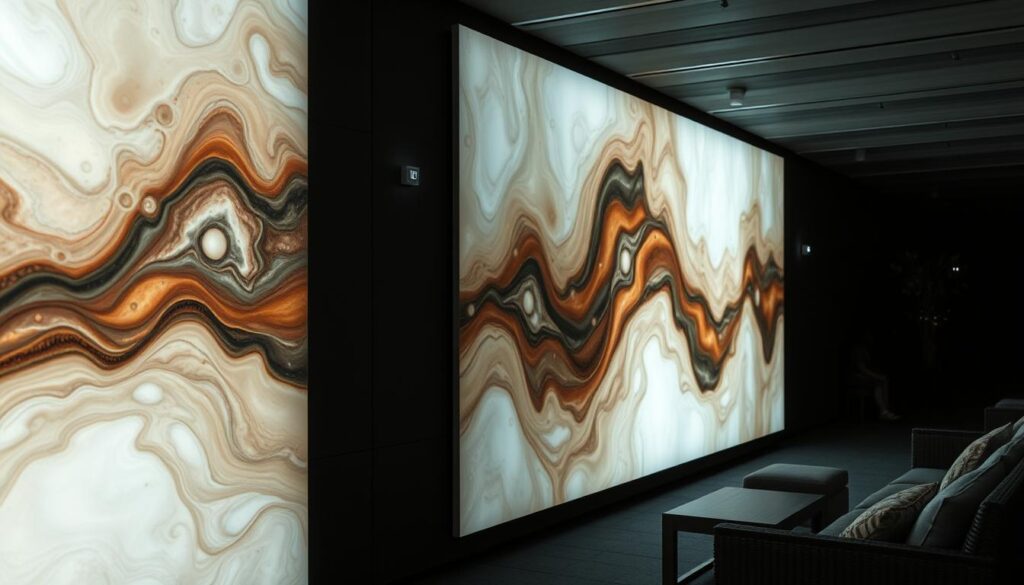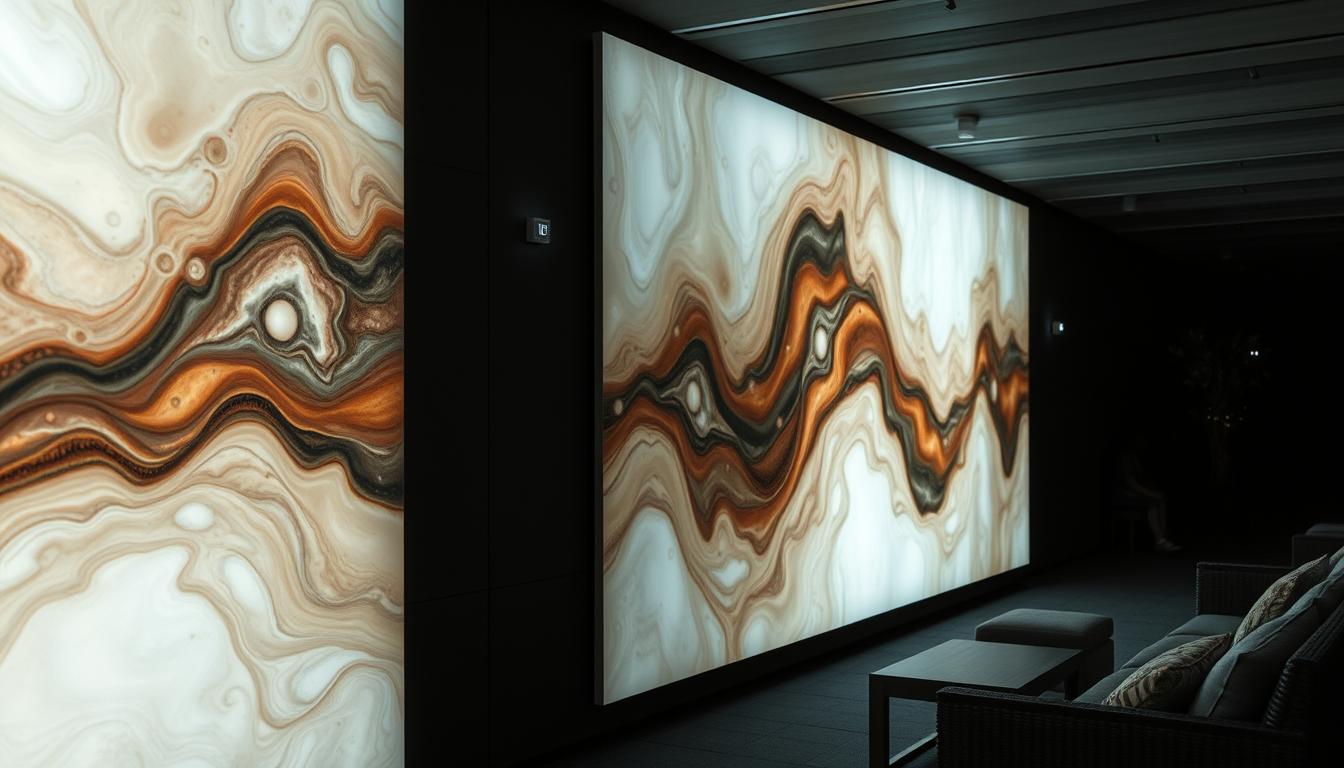A new art experience is sweeping the globe. This painting changes with the weather, offering a unique visual treat. It uses special pigments that react to the environment, making it stand out.

This art form is not just beautiful but also breaks new ground. It combines weather-responsive art with an immersive experience. This makes it a must-see for art lovers, especially those who enjoy interactive pieces.
Key Takeaways
- This painting uses special pigments that respond to environmental factors
- It is a unique piece of weather-responsive art
- The artwork creates a dynamic and interactive visual experience
- It is a masterpiece of interactive art
- The painting changes with the seasons, making it a must-see for anyone interested in art
- The innovative use of weather-responsive art pushes the boundaries of what we consider “art”
The Magic Behind Weather-Responsive Art
Weather-responsive art is a special kind of environmental art. It changes with the weather. It uses special pigments that react to things like temperature and light.
This art is always changing. It’s like a living, breathing piece that interacts with its surroundings.
The secret to this art is weather-sensitive pigments. These pigments change color or texture with the environment. For instance, they might turn from blue to red with warmer temperatures.
This technology lets artists create interactive art. It engages viewers in a unique way.
Several things can make weather-responsive art change. These include:
- Temperature: Changes in temperature can cause the pigments to change color or texture.
- Humidity: High humidity can cause the pigments to become more vibrant or intense.
- Light: Changes in light can cause the pigments to change color or appear more or less transparent.
Artists use weather-responsive art to create unique pieces. These pieces challenge our views of nature. This art form inspires new ways of creating and engages audiences in a dynamic way.
A New Dawn in Interactive Art Expression
Weather-responsive art has opened a new chapter in interactive art. Artists use technological advancements to make art that changes with the weather. This new art form could change how we see and interact with art.
Weather-responsive art offers a unique experience for viewers. As the weather shifts, the art changes too. This makes each viewing a new adventure, engaging the audience more deeply.
Here are some ways weather-responsive art can expand artistic expression:
- Integrating sensors and programming to respond to environmental changes
- Using technological advancements to create immersive and interactive experiences
- Collaborating with artists from diverse disciplines to push the boundaries of interactive art
The future of art looks bright with weather-responsive art and technological advancements. This new art form promises to inspire many with its interactive and dynamic nature.
The Artist’s Vision and Creative Process
Making a weather-responsive painting is a complex task. It needs a deep understanding of artistic vision and creative process. The artist mixes traditional art with technological advancements to create something unique and interactive.
The goal is to make an immersive experience. This experience changes and grows with the environment. It makes the art piece dynamic and engaging.
Some key parts of the artist’s vision and creative process include:
- Experimenting with different materials and techniques to achieve the desired effect
- Collaborating with experts in various fields, such as technology and environmental science
- Pushing the boundaries of what is possible with art and technology
The outcome is a painting that shows the artist’s artistic vision. It also uses technological advancements for an innovative and interactive experience. This art combines nature and artificial intelligence in a new way.
How This Painting Changes with the Weather
The painting that changes with the weather is a unique example of weather-responsive art. It reacts to different environmental factors like temperature, humidity, and light. This makes it a dynamic and interactive piece.
Some ways this painting changes include:
- Color: The painting’s colors may become more vibrant or muted in response to changes in temperature and light.
- Shape: The painting’s shapes and patterns may shift or change in response to changes in humidity and air pressure.
- Pattern: The painting’s patterns and textures may become more intricate or simplified in response to changes in wind and precipitation.
This innovative art uses weather-responsive art and environmental factors. It offers a truly immersive experience. Viewers can engage with the painting in a new and dynamic way.
Experiencing the Artwork Through Seasons
The artwork changes with the seasons, offering a dynamic and engaging visual experience. It’s a unique form of environmental art. As seasons change, the painting reflects the environment, creating an immersive experience for viewers.
This technology opens up new ways to create interactive art. It pushes the limits of modern art.
The artwork’s transformations can be broken down into several key periods, including:
- Summer: Warm colors and vibrant patterns emerge, reflecting the long days and sunny weather.
- Winter: Cool tones and icy textures dominate, evoking the chill and serenity of the season.
- Spring and Fall: Soft pastels and gentle hues appear, capturing the delicate beauty of these transitional seasons.
This artwork invites viewers to see the beauty of seasonal changes in a new way. It shows the importance of environmental art. By using interactive art technology, it offers a unique and engaging experience. It inspires viewers to think about the relationship between art and the environment.
Installation Requirements and Optimal Viewing
When showing weather-responsive art, installation requirements are key. They help make the art look its best. Think about how temperature, humidity, and light might change the artwork’s look.
To make sure the art works right, follow certain installation requirements. Pick a spot with steady temperature and humidity. Also, make sure it gets the right amount of light. This affects how well you can see it.
Some important things to think about for installation requirements are:
- Temperature range: 60-80°F (15-27°C)
- Humidity level: 40-60%
- Light exposure: indirect natural light or controlled artificial lighting
By considering these environmental factors and following the installation requirements, you can make a great display. This will let everyone see the art’s special features in the best way.

The Impact on Modern Art Collections
Modern art collections are changing with weather-responsive art. This new art form is pushing the limits of what we think art can be. It’s making museums and collectors think differently about art and the environment.
Museum curators have mixed views on this change. Some see it as a chance to draw in more people. Private collectors are also weighing in, considering the value and meaning of these special pieces.
Some important things to think about for modern art collections include:
- How to keep weather-sensitive parts safe
- What’s the best way to show off these pieces?
- How can weather-responsive art get people more involved?
As curators and collectors share their thoughts, modern art collections will grow more varied and lively. Weather-responsive art could change how we see and engage with art. Its effects will be seen for many years.
By welcoming this new art, collections can lead in creativity and innovation. They offer visitors unique and memorable experiences. The influence of weather-responsive art on modern collections is clear. It’s shaping the art world in exciting and unexpected ways.
Maintenance and Care Guidelines
To keep your weather-sensitive painting looking great, you need to take good care of it. Check the weather-sensitive parts often and fix any problems right away. This way, you can avoid damage and make the painting last longer.
Some important care steps include checking the painting for wear or damage, cleaning it gently, and storing it in a safe place when not on display. It’s also key to fix common problems like faded colors or broken sensors to stop more damage.
- Avoid exposing the painting to extreme temperatures or humidity levels
- Use gentle cleaning products and avoid harsh chemicals
- Handle the artwork with care to prevent physical damage
By sticking to these care tips and doing regular maintenance, you can enjoy your weather-sensitive painting for many years. Fixing common problems quickly and getting help from experts when needed can also help keep your painting in top shape.
Similar Innovations in Interactive Art
Interactive art is getting more popular. Artists use new technologies to make art that moves and grabs your attention. This new way of art lets viewers become part of the art itself.
For example, some art uses sensors and AI to react to how people move. This tech makes art that pulls you in and changes how you see things. Artistic expression is now more varied and thrilling, thanks to interactive art.
As tech keeps getting better, we’ll see more cool interactive art. We might see virtual reality or augmented reality art. Artists can now make complex, interactive pieces that were once impossible.

Interactive art has many benefits. It makes art more personal and memorable. Museums and galleries can attract more people by adding interactive art to their collections. This makes them stand out from traditional art places.
The future of interactive art is exciting. With innovative technologies and artistic expression, we’ll see even more amazing things. Interactive art will keep changing how we see the relationship between artist, viewer, and art.
Future Applications and Possibilities
The tech behind weather-responsive art could change many parts of our lives. We’ll see it in architecture, education, and business soon. This tech has a lot of future applications.
Picture a building that changes color with the weather. Or a classroom that teaches about the environment through art. These ideas show the architectural integration and educational opportunities this tech offers.
Expanding the Boundaries of Art
Weather-responsive art’s possibilities are vast. We’ll see new uses in public art and private collections. This tech could change how we see and interact with art.
Commercial Potential
This tech also has big commercial potential. Companies can use it for interactive ads or new products that change with the weather.
As we explore weather-responsive art, we’ll find new uses in many areas. It promises to impact our world through architectural integration, educational opportunities, and future applications.
The Environmental Message Behind the Art
The painting changes with the weather, sending a strong environmental message. It shows how crucial conservation and sustainability are. The creator uses technological advancements to make a special kind of artistic expression that connects with nature.
This new way of art challenges old ideas about art and nature. It makes people aware of the need to save our planet. The painting’s changes remind us of how our actions affect the environment, urging us to act.
Some important parts of the painting’s environmental message are:
- It shows how climate change affects our planet
- It pushes for sustainability and conservation
- It encourages viewers to think about their environmental impact
The mix of artistic expression and technological advancements creates a unique and inspiring art piece. It makes viewers think about their connection to the environment.
Conclusion
This painting that changes with the weather shows how weather-responsive art changes our view of art. The artist’s use of new technology and materials has opened a new world in art. It mixes nature and human creativity in a unique way.
The painting’s ability to change with the weather is not just beautiful. It also sends a strong message about taking care of our planet. It makes us stop and think about how delicate our world is. It reminds us of our duty to protect it.
The future of weather-responsive art is very promising. It could change how we see modern art and connect with it. It could be used in buildings, schools, and even business. This could lead to a new era in how we see and interact with the world.
FAQ
What is the unique feature of the weather-responsive painting?
The painting uses special pigments that change with the weather. This creates a dynamic and interactive visual experience.
How do the weather-sensitive pigments work?
The pigments in the painting react to temperature, humidity, and sunlight. This triggers changes in the painting’s color, shape, and pattern.
What is the artistic significance of weather-responsive art?
Weather-responsive art, like this painting, challenges old ideas about art and the environment. It offers a dynamic and engaging visual experience that interacts with nature.
How does the painting’s ability to change with the seasons enhance the viewing experience?
The painting’s changes through the seasons make for a unique and captivating experience. From summer’s vibrant hues to winter’s subtle variations, it adds an extra layer of interaction.
What are the installation requirements for the weather-responsive painting?
The painting needs specific conditions to work best, like proper lighting and temperature. The article guides on how to install it for the best visual impact.
How can weather-responsive art impact modern art collections?
Weather-responsive art, like this painting, challenges old ideas about art. It can significantly impact modern art collections, engaging viewers in new ways.
What are the maintenance and care guidelines for the weather-responsive painting?
Proper care is key to preserving the painting’s weather-sensitive elements. The article offers tips on troubleshooting and preserving the painting’s unique properties.
What are some similar innovations in interactive art?
The weather-responsive painting is part of a trend in interactive art. Artists are using new technologies to create dynamic visual experiences. The article explores these innovations and their impact on art.
What are the future applications and possibilities of weather-responsive art?
Weather-responsive art could be used in architecture, education, and commerce. It offers new opportunities for interactive and environmentally-conscious art. The article discusses these possibilities and their future impact.
What is the environmental message behind the weather-responsive painting?
The painting not only offers a dynamic visual experience but also carries an important environmental message. It challenges old ideas about art and the environment, highlighting the need for conservation and awareness about climate change.
